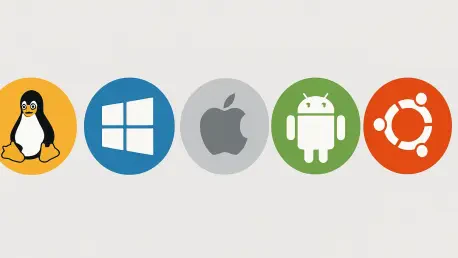In an era where technology defines how societies function, the operating system market is experiencing an unprecedented shake-up. For nearly four decades, Windows held a near-monopoly across personal computers. Yet today, consumer dissatisfaction with issues like privacy has opened doors to alternatives such as Linux and macOS. This shift carries profound implications for enterprises and individuals alike. It is a time ripe with opportunity and challenge as systems that prioritize user control and privacy begin to take hold in this dynamic landscape.
Operating System Market Trends
Recent data shows Windows still leads the market but with a notable decline, now holding 63.2% in the US. This drop is a testament to changing preferences as consumers seek out viable alternatives. Linux, though traditionally viewed as niche, has surpassed a 5% market share, securing its role as an emerging contender. Apple’s macOS further solidifies a desire for systems perceived as secure. The decline in Windows can be attributed not only to privacy concerns but also to what users deem an ‘upgrade tax,’ prompting migration toward more flexible platforms.
Linux, often praised for its open-source nature, appeals to users seeking control over digital environments devoid of adware or intrusive updates. Moreover, its community-driven approach enhances security and the ability to tailor functionality. On the other hand, macOS captivates users through aesthetics and seamless integration with Apple’s ecosystem. This has translated into greater user acceptance. As technology unfolds to address privacy and control, operating systems embracing these values gain traction.
Insights on Future Projections
The trajectory of operating systems is diversifying into a competitive realm. Large-scale reliance on a singular OS, particularly one vulnerable to privacy scrutiny like Windows, is giving way to models embracing resilience and diversified options. As enterprises pivot towards adopting multiple platforms, security enhancement becomes paramount. Additionally, open-source solutions like Linux are likely to thrive as trust in monolithic tech companies wanes. This disruption could reshape traditional OS paradigms and usher in new standards fostering innovation and user autonomy.
Conclusion
This period marks a burgeoning interest in alternatives that prioritize user-centric features such as privacy and control. As users examine these options, strategic approaches emerge. Businesses that adapt to this shift benefit from technological diversification, leveraging new systems to fortify security infrastructures. Companies embrace multi-platform strategies to minimize exposure and maximize innovation.
These dynamics leave stakeholders tasked with understanding user intent and ensuring the alignment of technologies with evolving preferences. It is crucial to integrate what makes Linux and macOS appealing—autonomy, privacy, control—into existing ecosystems. This insight provides a roadmap for maintaining relevance and competitiveness in a transformed digital landscape, urging them to consider how future commitments might solidify these strategies.









